PPC
8 Ways to Use AI for Holiday Marketing (+15 Prompts to Get Started!)

To say AI has grown in recent years would be the understatement of the century. A few years back, AI was largely a buzzword, with its use cases predominately limited to predictive analytics and chatbots. (This is grossly simplifying things, but you get the point.) Now, we’ve reached a point where you can ask, “Are there ways to use AI for holiday marketing?” And, voila—this question warrants an entire article. Written by a human, of course.
If you’re looking to answer said question and snag a few generative AI prompts while you’re at it, you’ve come to the right place.
Table of contents
How AI is used in marketing
Before we dive into the ways you can use AI for holiday marketing, it’s important to understand the basics of how AI is used in marketing. (Although if you’d like to skip right to the ideas, feel free to do so here!).
AI for analytics
Marketing analytics and AI have gone hand in hand for some time now. In the past, AI played a smaller role in analytics, helping with segmentation and even suggesting keywords to target.
Today, AI powers real-time insights for social posts and ads, allowing marketers to pivot ad spend or ad copy on the fly.
Current AI also allows for more improved targeting. Using AI-powered platforms, you can analyze your current audience groups and demographics, and weigh them against your competitors, past campaign performance, and more.
These emergent uses of AI in analytics, coupled with good old-fashioned historical analytics data, can result in more refined decision-making and the ability to pivot on a dime.
🤖 Get practical tips to use AI the right way >> The Emergency Guide to AI in Marketing
AI for chatbots
Using AI, chatbots can deliver more advanced responses to site visitors. This enables more timely, helpful support, as the chatbot can either resolve the issue or route the person to the correct department.
Advanced AI-powered chatbots can take support even further, answering product questions and making recommendations. This opens up the door to more cross or upselling opportunities.

Personalized recommendations with AI
For years now, online stores have used machine learning algorithms to recommend products and services to shoppers. Now, modern AI can pull from browsing data to serve recommendations in real time.
Coupled with historical shopping habits, this allows for a more personalized, tailored shopping experience.
Generative AI
Generative AI is all the rage right now, with companies like ChatGPT and Jasper becoming borderline household names. Generative AI is a form of machine learning that uses natural language processing (NLP) to learn from large sets of structured data and then create a deliverable to the best of its predictive ability.
Generative AI is largely thought of as a way to generate blogs and school papers, but it’s capable of much more. Generative AI can help you brainstorm marketing campaigns, email copy, social media posts, and virtually any other campaign asset.
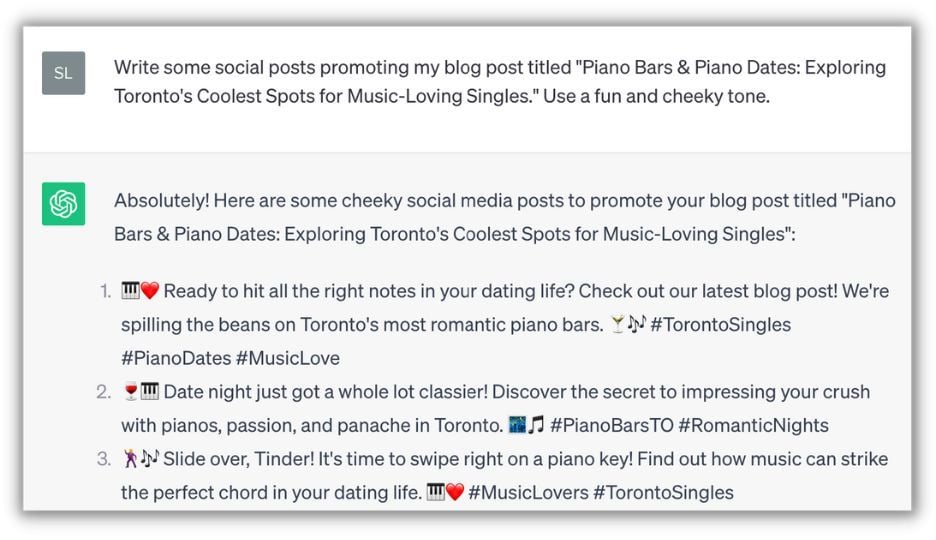

8 ways to use AI for holiday marketing
Now that you’re an AI expert, it’s time to use this impressive and terrifying power for some holiday good.
1. Tailor holiday ad copy
There’s nothing wrong with handling your ad ideation and copy by hand. But, if AI is available, why not squeeze a little juice out of it?
There are a number of AI tools that allow you to utilize your current data to improve segmentation. Coupled with your funnel and customer journey knowledge, you can use AI to help you create holiday ad copy that’s ready to meet your customers wherever they’re at.
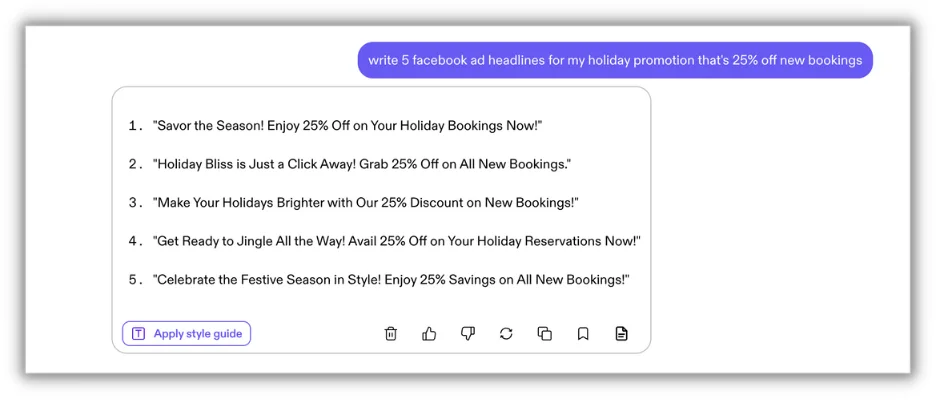

For example, you could use AI to help you create several variations of ads for the same holiday-themed campaign, each one targeting those at different stages and from different audience segments. You can then take things a step further and use AI to help you reshape some of these ads to offer product recommendations in line with the shopper’s previous habits.
🎁 Want ideas for your holiday campaigns? Get the guide >> Holiday Promotions, Campaigns & Social Posts to Unwrap
2. Personalize product recommendations
The holidays are a time of joy and cheer–and a ton of shopping. Using AI you can help streamline shopping for your customers, delivering more accurate and timely product recommendations based on their browsing of your store.
Amazon is a prime example of using AI to make accurate product recommendations. Not only do they suggest products on a product page, they also have a “Top picks” section where they offer even more suggestions.
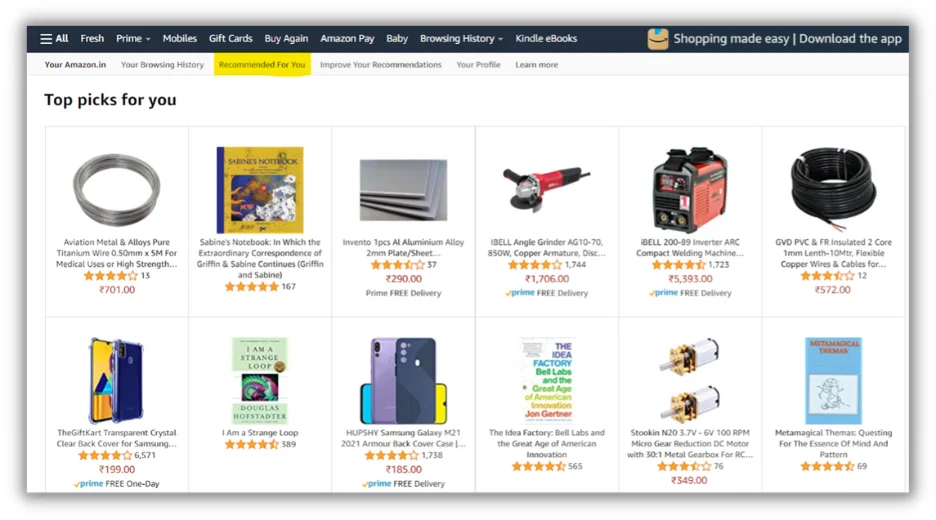

If you’re not already using it, implement AI-powered product recommendations before the holidays and help your customers find gifts they didn’t even know they were looking for.
3. Optimize cross-channel holiday campaigns
The holidays are a sales-packed, hectic time for many shoppers. During this time of year, it’s not uncommon for customer journeys to be condensed or expedited, as many people are in crunch mode and skimping on research. With the right AI-powered tools, you can keep up with the wildest of holiday journeys.
- Use advanced analytics to monitor campaign and ad performance in near real-time.
- Make tweaks to landing pages, emails, ads, etc. on the fly to counter bounce rates.
- Pair AI with any number of AI personalization tools to deliver customized page experiences for shoppers based on their behavior.
- Leverage AI-powered chatbots to support customers during hectic holiday campaigns.
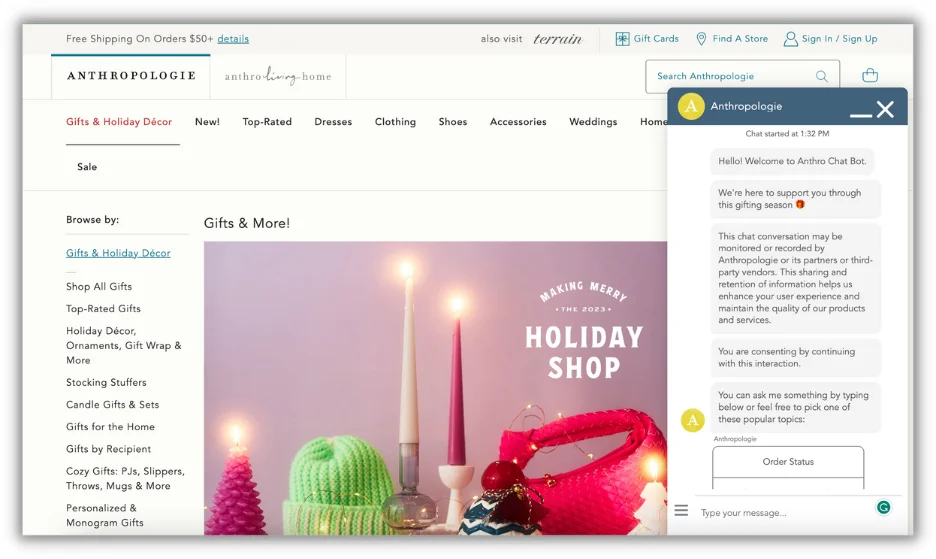

With all the above efforts combined, you can quickly alter your campaigns during the holiday season. If people aren’t resonating with a certain piece of your campaign or a particular discounted holiday special isn’t performing as planned, course correct on the go!
4. Improve customer support routing
Customers are bound to need help during the holiday hustle and bustle. With the right AI chatbot and routing systems, you can help customers get the help they need during what should be a fun, not stressful, time of the year.
- Set up chatbots to not only offer help with sales but also offer product recommendations.
- Make sure your chatbot can direct people to the right department and that someone is available when they’re redirected.
- Utilize AI-powered call routing that looks at previous call history and sentiment to ensure people get in touch with the right person at the right time.
- For bonus points, set your chatbot to include fun holiday greetings or language in the introductory chat.
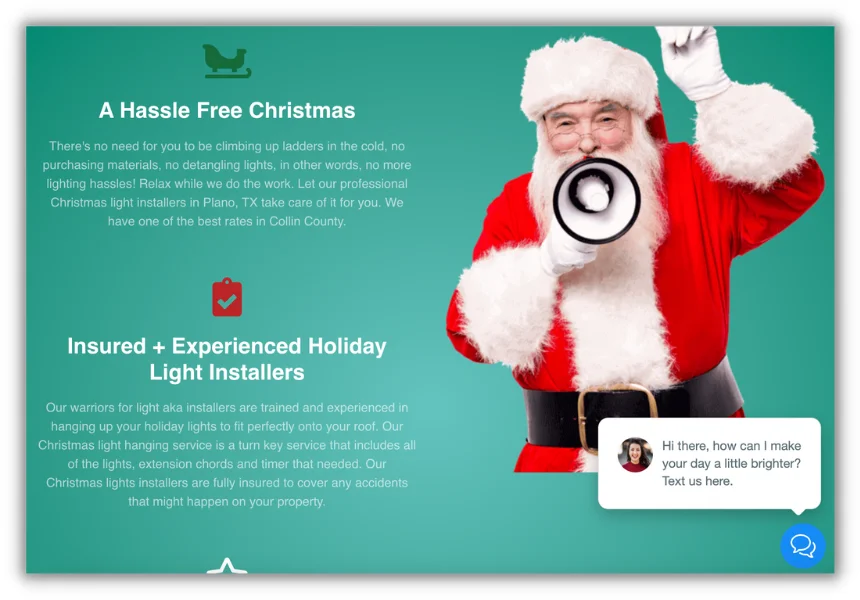

There are a number of AI chatbots and call routing systems, so shop around and find the one that fits your budget and needs.
Most importantly: test any chatbots and call systems you put in place. The last thing you want is an AI-powered chatbot that’s sending people to a 404 page.
5. Simpler sales forecasting
The days of manually poring over historical data are over. Well, not over, but hopefully simpler, thanks to AI.
The last thing you want is for products to go out of stock during the holidays. Before the holiday rush, couple your noggin with one of the many AI-powered sales forecasting platforms. Then, use the tool to examine your previous sales and predict which products are most likely to go out of stock, which are less popular, and so on.
If you don’t have previous holiday data on a particular product, or your company is new, don’t fret! Many AI tools are capable of looking at any available historical data, as well as market data and trends, to help you get an idea of how a product might perform in the future.
6. Real-time ad placement
People are bound to hop around during the holidays, going from one site to another. Fortunately, there are a number of AI-powered ad platforms that are capable of serving up your ads where they make the most sense.
Pair this real-time ad placement tech with your many holiday campaign optimization tricks from earlier, and you can collectively pivot all your holiday assets with ease and maximize your ROI.
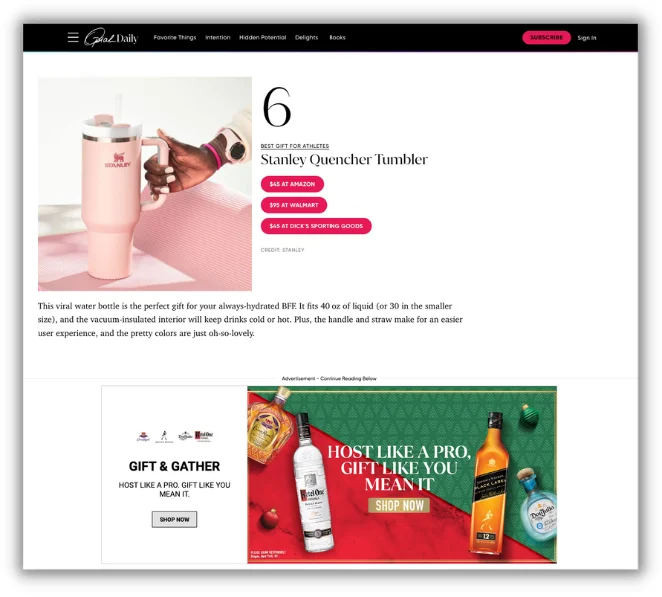

This holiday ad showed up perfectly within a post about holiday gift ideas.
7. Streamline hashtags for social
The right hashtags go a long way, increasing the chances your posts are seen by users exploring various trends. The wrong hashtags, on the other hand, can result in your content getting lost in a sea of unrelated posts.
There are a number of AI platforms made just for this task. With one of these tools, you can enter your audience and campaign information, then generate swaths of hashtag suggestions based on the market.
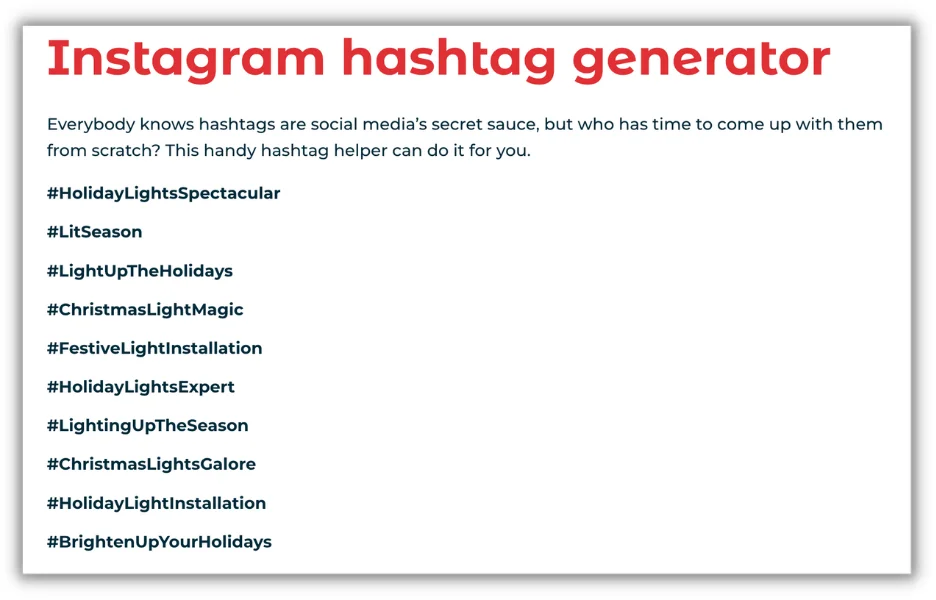

While you should still manually investigate each hashtag before posting anything, these tools can save you precious time—time you can spend monitoring and altering your campaigns.
8. Campaign brainstorming
Generative AI is great for brainstorming individual marketing assets or even entire campaigns, including upcoming holiday efforts. In a few quick steps, you can find the right generative AI platform and start crafting holiday campaign content today.
Find the right platform
There are a number of generative AI platforms, so do your due diligence and see which ones fit your budget and use cases the best. Some platforms charge based on use, while others offer tiered pricing based on the number of seats.
Many platforms will perform similarly, typically using OpenAI to power their generative wizardry. But, take note of any templates or niche features the tools offer. Some platforms are focused more on expediting blogs, while others are focused on content as a whole and offer a number of useful templates.
Feed your generative AI
Once you’ve landed on an AI platform, give the AI thorough brand and audience information to ensure the results are as accurate and tailored as possible.
Some platforms give you the option to submit any links or blog posts you’re comfortable sharing, giving the AI the chance to learn your brand’s voice. This feature can be especially valuable, saving you the time of having to train the AI and resulting in more on-brand results sooner.
Collaborate on campaign ideas
Finally, come up with some high-level campaign ideas, input them into the AI, and watch the magic happen. Some platforms will give you the option to generate ideas for every element of a campaign—blog topics, emails, social posts, and more—while others will simply generate themes for your campaign.
Keep in mind you should always treat AI-generated content as a jumping-off point, not the final copy. You, the person, should always oversee the AI. You know your brand better than any AI or machine learning ever could. Use whatever it gives you as inspiration and write something original that will wow your audience!
20 holiday AI prompts for marketing
Generative AI can help you whether you’re in a creative rut or looking to produce marketing content more quickly. But you need effective prompts, otherwise, you’ll get generic results that don’t even function as jumping-off points or inspiration.
Put holiday cheer into your generative AI journey with these prompts, broken down by content type. Also, be sure to tweak these prompts with any modifiers you want. (Much like generative AI results, these are just jumping-off points.)
Email marketing holiday prompts
- Generate a holiday themed subject line promoting _____ for our company ____ that has a sense of urgency
- Construct a catchy holiday themed subject line that invites users to shop our new line of _____
- Generate a holiday themed subject line that’s funny/inviting/intriguing and promotes an upcoming sale
- Write a warm subject line that invites users to reflect on their year and check out holiday sale
- Generate a holiday themed subject line pitching X% off our entire line of _____ that includes emojis


Get more holiday marketing email ideas here, including templates, subject lines, and examples!
Social media holiday prompts
- Design a fun and festive holiday sale announcement for our ____ company
- Write an inviting holiday themed social media post about our new _____ product
- Generate a 100-word post that invites users to do their holiday shopping this year at COMPANY NAME, which sells _____ products
- Write a compelling pitch for the header of a social media post promoting a holiday sale of _____
- Write a social media post that targets ____ audience and ____ industry and promotes sale/product launch/holiday shopping


Get more ideas for holiday social media posts here!
Content marketing holiday AI prompts
- Write five blog titles that invoke the holidays and pitch ____ audience on our new product _______
- Outline X points for a blog article that’s holiday-themed and targets ____ audience with information about _____
- Write a blog pitch in ____ tone that’s holiday-themed and includes information on ____ for ___ audience
- Write a paragraph on _____ topic that targets ____ audience and includes holiday themes
- Generate X marketing blog topics that focus on the holidays and inform ____ audience on ____
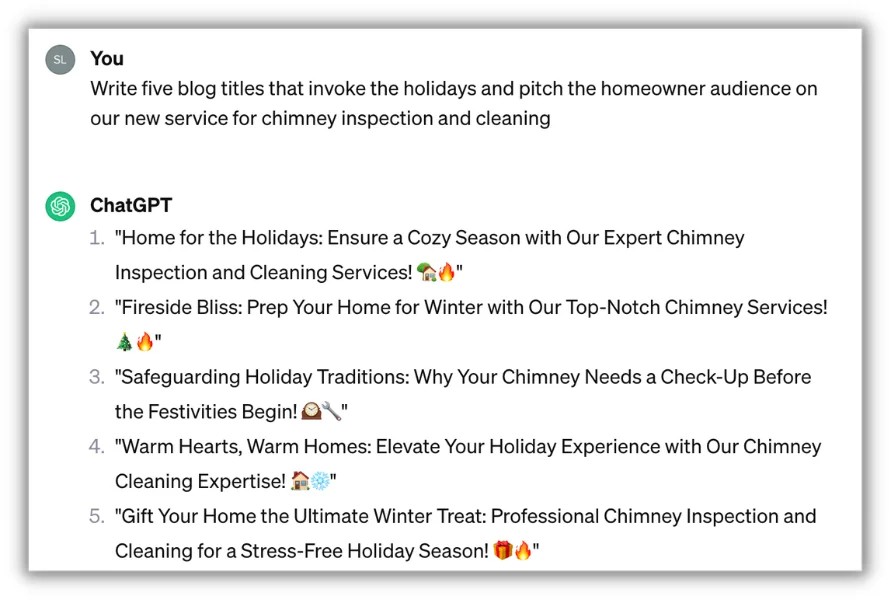

Real success with artificial intelligence
AI can be a helpful asset for your marketing strategy throughout the year, but it can be especially helpful as you’re trying to close out the year strong during the holidays!
Here are 8 ways to use AI for holiday marketing:
- Tailor ad copy
- Personalize product recommendations
- Optimize cross-channel holiday campaigns
- Improve customer support routing
- Simpler sales forecasting
- Real-time ad placement
- Streamline hashtags for social
- Holiday campaign brainstorming
Looking for more holiday inspiration?

















